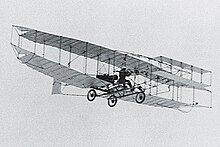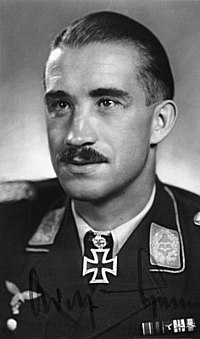
Adolf Josef Ferdinand Galland was a German Luftwaffe general and flying ace who served throughout the Second World War in Europe. He flew 705 combat missions, and fought on the Western Front and in the Defence of the Reich.
Galland, who was born in Westerholt, Westphalia became a glider pilot in 1929 before he joined the Luft Hansa. In 1932, he graduated as a pilot at the Deutsche Verkehrsfliegerschule (German Commercial Flyers' School) in Braunschweig before applying to join the Reichswehr of the Weimar Republic later in the year. Galland's application was accepted, but he never took up the offer. In February 1934, he was transferred to the Luftwaffe. In 1937, during the Spanish Civil War, he volunteered for the Condor Legion and flew ground attack missions in support of the Nationalists under Francisco Franco. After finishing his tour in 1938 Galland was employed in the Air Ministry writing doctrinal and technical manuals about his experiences as a ground-attack pilot. During this period Galland served as an instructor for ground-attack units. During the German invasion of Poland in September 1939, he again flew ground attack missions. In early 1940, Galland managed to persuade his superiors to allow him to become a fighter pilot.
Galland flew Messerschmitt Bf 109s during the Battle of France and the Battle of Britain. By the end of 1940, his tally of victories had reached 57. In 1941, Galland stayed in France and fought the Royal Air Force (RAF) over the English Channel and Northern France.
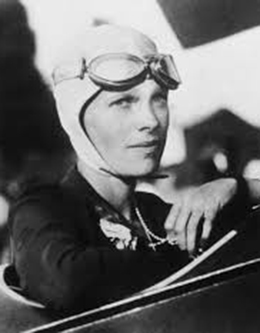
Amelia Mary Earhart born July 24, 1897; disappeared July 2, 1937; declared dead January 5, 1939) was an American aviation pioneer and writer. Earhart was the first female aviator to fly solo across the Atlantic Ocean. She set many other records, was one of the first aviators to promote commercial air travel, wrote best-selling books about her flying experiences, and was instrumental in the formation of The Ninety-Nines, an organization for female pilots.
Born and raised in Atchison, Kansas, and later in Des Moines, Iowa, Earhart developed a passion for adventure at a young age, steadily gaining flying experience from her twenties. In 1928, Earhart became the first female passenger to cross the Atlantic by airplane (accompanying pilot Wilmer Stultz), for which she achieved celebrity status. In 1932, piloting a Lockheed Vega 5B, Earhart made a nonstop solo transatlantic flight, becoming the first woman to achieve such a feat. She received the United States Distinguished Flying Cross for this accomplishment. In 1935, Earhart became a visiting faculty member at Purdue University as an advisor to aeronautical engineering and a career counselor to female students. She was also a member of the National Woman's Party and an early supporter of the Equal Rights Amendment. Known as one of the most inspirational American figures in aviation from the late 1920s throughout the 1930s, Earhart's legacy is often compared to the early aeronautical career of pioneer aviator Charles Lindbergh, as well as to figures like First Lady Eleanor Roosevelt for their close friendship and lasting impact on the issue of women's causes from that period.
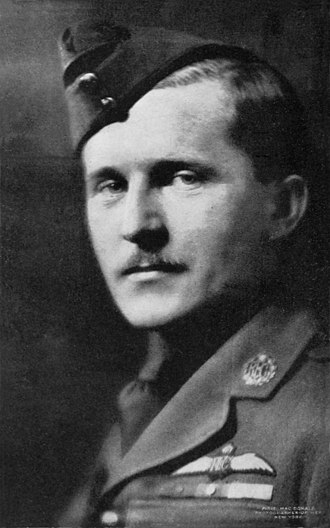
Air Marshal William Avery Bishop, VC, CB, DSO & Bar, MC, DFC, ED (8 February 1894 – 11 September 1956) was a Canadian flying ace of the First World War. He was officially credited with 72 victories, making him the top Canadian and British Empire ace of the war, and also received a Victoria Cross. During the Second World War, Bishop was instrumental in setting up and promoting the British Commonwealth Air Training Plan.
Early life
William Avery Bishop (commonly called Billy Bishop to distinguish him from his father) was born in Owen Sound, Ontario, on 8 February 1894, blond, blue-eyed, and weighing 11 pounds. He was the third of four children born to William Avery Bishop Sr. and Margaret Louisa (Green) Bishop. William Avery Bishop Sr. was a lawyer and graduate of Osgoode Hall Law School in Toronto, Ontario. He was the Registrar of Grey County; he was appointed to the post after backing the winning Liberal Party candidate in the national elections of 1896. He was consequential enough to be invited to a dinner for British dignitaries hosted by Prime Minister Sir Wilfrid Laurier.
Eldest brother Worth was ten years old when Billy arrived. His other brother, Kilbourn, was born in 1886, but died in 1893, the year before Billy's birth. Sister Louise, to whom Billy became very close, was born in 1895, a year after him.
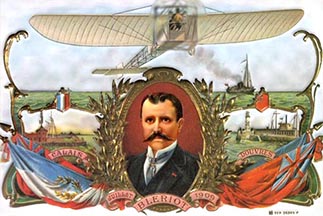
Louis Charles Joseph Blériot (1 July 1872 – 1 August 1936) was a French aviator, inventor, and engineer. He developed the first practical headlamp for cars and established a profitable business manufacturing them, using much of the money he made to finance his attempts to build a successful aircraft. Blériot was the first to use the combination of hand-operated joystick and foot-operated rudder control as used to the present day to operate the aircraft control surfaces. Blériot was also the first to make a working, powered, piloted monoplane. In 1909 he became world-famous for making the first airplane flight across the English Channel, winning the prize of £1,000 offered by the Daily Mail newspaper. He was the founder of Blériot Aéronautique, a successful aircraft manufacturing company.
Early years
Born at No.17h rue de l'Arbre à Poires (now rue Sadi-Carnot) in Cambrai, Louis was the first of five children born to Clémence and Charles Blériot. In 1882, aged 10, Blériot was sent as a boarder to the Institut Notre Dame in Cambrai, where he frequently won class prizes, including one for engineering drawing. When he was 15, he moved on to the Lycée at Amiens, where he lived with an aunt. After passing the exams for his baccalaureate in science and German, he determined to try to enter the prestigious École Centrale in Paris. Entrance was by a demanding exam for which special tuition was necessary: consequently Blériot spent a year at the Collège Sainte-Barbe in Paris. He passed the exam, placing 74th among the 243 successful candidates, and doing especially well in the tests of engineering drawing ability. After three years of demanding study at the École Centrale, Blériot graduated 113th of 203 in his graduating class. He then embarked on a term of compulsory military service, and spent a year as a sub-lieutenant in the 24th Artillery Regiment, stationed in Tarbes in the Pyrenees.
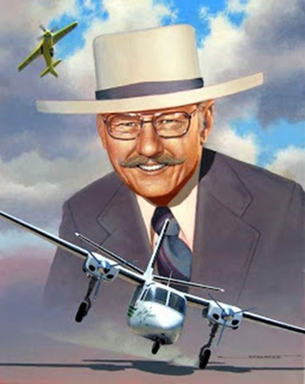
Robert Anderson Hoover (January 24, 1922 – October 25, 2016) was an American fighter pilot, test pilot, flight instructor, and record-setting air show aviator.
Hoover flew Spitfires in the United States Army Air Forces during World War II and was shot down in 1944 off the coast of France. He was held for over a year in a German POW camp before eventually escaping and flying to safety in a stolen enemy aircraft. He then worked as a United States Air Force and civilian test pilot after the war, flying chase for Chuck Yeager's Bell X-1 supersonic flight in 1947, and as a flight instructor for North American Aviation during the Korean War.
He is best known as an air show display pilot, who flew for nearly 50 years until his retirement in 1999. Known as the "pilot's pilot", Hoover revolutionized modern aerobatic flying and has been described in many aviation circles as one of the greatest pilots of all time. He received the Distinguished Flying Cross and Wright Brothers Memorial Trophy, and was inducted into the National Aviation Hall of Fame in 1988 and Aerospace Walk of Honor in 1992, along with several other military and civilian awards and accolades. In 2013, Flying magazine ranked him 10th on its list of the 51 Heroes of Aviation.

Brigadier General Charles Elwood Yeager (February 13, 1923 – December 7, 2020) was a United States Air Force officer, flying ace, and record-setting test pilot who in October 1947 became the first pilot in history confirmed to have exceeded the speed of sound in level flight.
Yeager was raised in Hamlin, West Virginia. His career began in World War II as a private in the United States Army, assigned to the Army Air Forces in 1941.[a] After serving as an aircraft mechanic, in September 1942, he entered enlisted pilot training and upon graduation was promoted to the rank of flight officer (the World War II Army Air Force version of the Army's warrant officer), later achieving most of his aerial victories as a P-51 Mustang fighter pilot on the Western Front, where he was credited with shooting down 11.5 enemy aircraft (the half credit is from a second pilot assisting him in a single shootdown). On October 12, 1944, he attained "ace in a day" status, shooting down five enemy aircraft in one mission.
After the war, Yeager became a test pilot and flew many types of aircraft, including experimental rocket-powered aircraft for the National Advisory Committee for Aeronautics (NACA). Through the NACA program, he became the first human to officially break the sound barrier on October 14, 1947, when he flew the experimental Bell X-1 at Mach 1 at an altitude of 45,000 ft (13,700 m), for which he won both the Collier and Mackay trophies in 1948. He then went on to break several other speed and altitude records in the following years. In 1962, he became the first commandant of the USAF Aerospace Research Pilot School, which trained and produced astronauts for NASA and the Air Force.
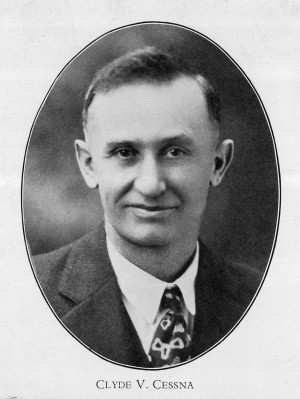
Clyde Vernon Cessna December 5, 1879 – November 20, 1954) was an American aircraft designer, aviator, and early aviation entrepreneur. He is best known as the principal founder of the Cessna Aircraft Corporation, which he started in 1927 in Wichita, Kansas.
Biography
Early years
Cessna was born on December 5, 1879, in Hawthorne, in Montgomery County, Iowa, the son of Mary Vandora (Skates) and James William Cessna. Cessna's family was of French and German ancestry. When he was two years old, his family moved to rural Rago in Kingman County, Kansas, along the Chikaskia River. During his boyhood he used his self-taught innovation and mechanical skills to improve farm machinery and to develop new farming methods. He later became a successful car dealer in Enid, Oklahoma.
Cessna's interest in aviation began in 1910 after witnessing an aerial exhibition in his home state of Kansas. It was this exhibition that led him in future years to pursue his career in aviation. After realizing his interest in aviation, Cessna left Oklahoma and moved to New York State where he worked for a short period at the Queen Aeroplane Company where he first learned about the construction of aircraft.
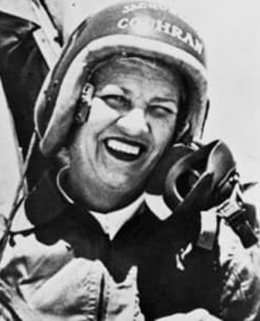
Jacqueline Cochran (May 11, 1906 – August 9, 1980) was an American pilot and business executive. She pioneered women's aviation as one of the most prominent racing pilots of her generation. She set numerous records and was the first woman to break the sound barrier on 18 May 1953. Cochran (along with Nancy Love) was the wartime head of the Women Airforce Service Pilots (WASP) (1943–1944), which employed about 1000 civilian American women in a non-combat role to ferry planes from factories to port cities. Cochran was later a sponsor of the Mercury 13 women astronaut program.
Early life
Jacqueline Cochran, born Bessie Lee Pittman, in Pensacola, (some sources indicate she was born in DeFuniak Springs) in the Florida Panhandle, was the youngest of the five children of Mary (Grant) and Ira Pittman, a skilled millwright who frequently relocated setting up and reworking sawmills. While her family was not wealthy, Cochran's childhood living in small-town Florida was similar to those in other families of the era. Contrary to some accounts, there was always food on the table and she was not adopted, as she often claimed.
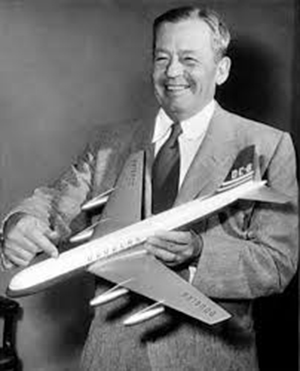
Donald Wills Douglas Sr. (April 6, 1892 – February 1, 1981) was an American aircraft industrialist and engineer.
An aviation pioneer, he designed and built the Douglas Cloudster. Though it failed in its intended purpose—being the first to fly non-stop across the United States—it became the first airplane with a payload greater than its own weight.
He founded the Douglas Aircraft Company in 1921 (the company later merged with McDonnell Aircraft to form McDonnell Douglas Corporation). Under his leadership, the company became one of the leaders of the commercial aircraft industry, engaging in a decades-long struggle for supremacy with arch-rival William Boeing and his eponymous enterprise. Douglas gained the upper hand, particularly with his revolutionary and highly successful Douglas DC-3 airliner and its equally popular World War II military transport version, the C-47; at the start of the war, his airplanes made up 80% of all commercial aircraft in service. However, he lagged behind in the jet age and was overtaken and surpassed by Boeing. He retired in 1957.
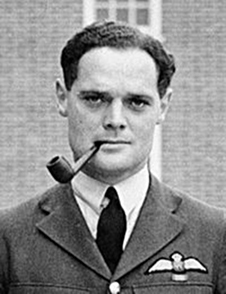
Group Captain Sir Douglas Robert Steuart Bader, CBE, DSO & Bar, DFC & Bar, DL, FRAeS 21 February 1910 – 5 September 1982) was a Royal Air Force flying ace during the Second World War. He was credited with 22 aerial victories, four shared victories, six probables, one shared probable and 11 enemy aircraft damaged.
Bader joined the RAF in 1928, and was commissioned in 1930. In December 1931, while attempting some aerobatics, he crashed and lost both his legs. Having been on the brink of death, he recovered, retook flight training, passed his check flights and then requested reactivation as a pilot. Although there were no regulations applicable to his situation, he was retired against his will on medical grounds.
After the outbreak of the Second World War in 1939, however, Douglas Bader returned to the RAF and was accepted as a pilot. He scored his first victories over Dunkirk during the Battle of France in 1940. He then took part in the Battle of Britain and became a friend and supporter of Air Vice Marshal Trafford Leigh-Mallory and his "Big Wing" experiments.
In August 1941, Bader baled out over German-occupied France and was captured. Soon afterward, he met and was befriended by Adolf Galland, a prominent German fighter ace. Despite his disability, Bader made a number of escape attempts and was eventually sent to the prisoner of war camp at Colditz Castle. He remained there until April 1945 when the camp was liberated by the First United States Army.
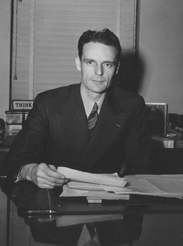
Dwane Leon Wallace (October 29, 1911 – December 21, 1989) was an American aviation businessman and aircraft designer. He served as the president and/or chairman of the board of the Cessna Aircraft Company from 1935 until the 1970s, having then continued on the board as a director and consultant into the 1980s. Wallace later became known as the "Quiet Giant of Aviation", and was posthumously inducted into the National Aviation Hall of Fame in 2012. He was included in the Flying Magazine list of the "51 Heroes of Aviation", placing at number 11.
Early life
Dwane Wallace was raised in Belmont, Kansas. He and his brothers Deane and Dwight, and sister Doreen, were children of physician Dr. Eugene Wallace and Grace Opal (Cessna) Wallace. Grace's brother was aviation pioneer Clyde Vernon Cessna, founder of Cessna Aircraft Company. Cessna became the first planemaker-aviator of the Great Plains in the year Dwane was born, and gave the brothers their first airplane ride in an OX-5 Swallow in 1924.
One account describes Wallace as having made up his mind at age 10 to make his life in aviation.

Dr. Ernst Heinkel (24 January 1888 – 30 January 1958) was a German aircraft designer, manufacturer, Wehrwirtschaftsführer in Nazi Germany, and member of the Nazi party. His company Heinkel Flugzeugwerke produced the Heinkel He 178, the world's first turbojet-powered aircraft, and the Heinkel He 176, the first rocket aircraft.
Early life
Heinkel was born in Grunbach, today a part of Remshalden. As a young man he became an apprentice machinist at a foundry. Heinkel studied at the Technical Academy of Stuttgart,[1] where he initially became interested in aviation through a fascination with Zeppelins, and in 1909 attended an international airshow in Frankfurt am Main. He decided that flight was the future of transportation, and the following year he built his first aircraft, working from a set of plans by Henri Farman. Heinkel crashed it in 1911 and suffered severe injuries.
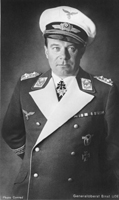
Ernst Udet (26 April 1896 – 17 November 1941) was a German pilot during World War I and a Luftwaffe Colonel-General (Generaloberst) during World War II.
Udet joined the Imperial German Air Service at the age of 19, and eventually became a notable flying ace of World War I, scoring 62 confirmed victories by the end of his life. The highest scoring German fighter pilot to survive that war, and the second-highest scoring after Manfred von Richthofen, his commander in the Flying Circus, Udet rose to become a squadron commander under Richthofen, and later under Hermann Göring. Udet spent the 1920s and early 1930s as a stunt pilot, international barnstormer, light aircraft manufacturer, and playboy.
In 1933, Udet joined the Nazi Party and became involved in the early development of the Luftwaffe, where he was appointed director of research and development. Influential in the adoption of dive bombing techniques as well as the Stuka dive bomber, by 1939 Udet had risen to the post of Chief of Procurement and Supply for the Luftwaffe. The stress of the position and his distaste for administrative duties led to Udet developing alcoholism.
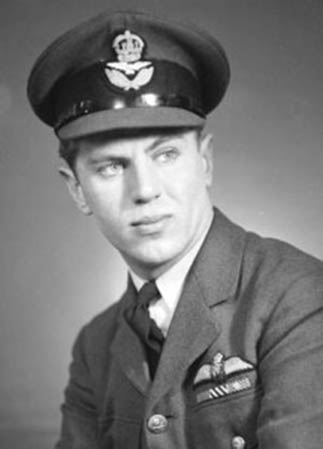
George Frederick "Buzz" Beurling, DSO, DFC, DFM & Bar (6 December 1921 – 20 May 1948) was the most successful Canadian fighter pilot and flying ace of the Second World War.
Beurling was recognised as "Canada's most famous hero of the Second World War", as "The Falcon of Malta" and the "Knight of Malta", having been credited with shooting down 27 Axis aircraft in just 14 days over the besieged Mediterranean island. Before the war ended his official total climbed to either 31 or 311⁄3.
Beurling's wartime service was terminated prior to war's end, for repeated stunting and his lack of teamwork. Having found a way to potentially continue combat flying in the postwar era, Beurling was killed in a crash while attempting to deliver an aircraft to Israel.
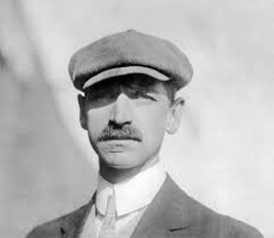
Glenn Hammond Curtiss (May 21, 1878 – July 23, 1930) was an American aviation and motorcycling pioneer, and a founder of the U.S. aircraft industry. He began his career as a bicycle racer and builder before moving on to motorcycles. As early as 1904, he began to manufacture engines for airships. In 1908, Curtiss joined the Aerial Experiment Association, a pioneering research group, founded by Alexander Graham Bell at Beinn Bhreagh, Nova Scotia, to build flying machines.
Curtiss won a race at the world's first international air meet in France and made the first long-distance flight in the U.S. His contributions in designing and building aircraft led to the formation of the Curtiss Aeroplane and Motor Company, which later merged into the Curtiss-Wright Corporation. His company built aircraft for the U.S. Army and Navy, and, during the years leading up to World War I, his experiments with seaplanes led to advances in naval aviation. Curtiss civil and military aircraft were some of the most important types in the interwar and World War II eras.
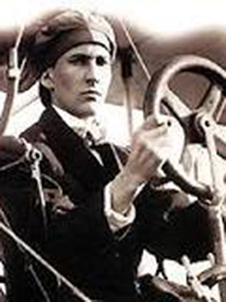
John Alexander Douglas McCurdy MBE, (2 August 1886 – 25 June 1961) was a Canadian aviation pioneer and the 20th Lieutenant Governor of Nova Scotia from 1947 to 1952.
Early years
Son of inventor Arthur Williams McCurdy and born in Baddeck, Nova Scotia, McCurdy was known as "Douglas". He was schooled at St. Andrew's College in Aurora, Ontario and graduated from the University of Toronto in mechanical engineering in 1907, where he had been a member of The Kappa Alpha Society along with his friend Frederick Walker Baldwin. The University of Toronto Year Book for his graduation year (Torontonensis 1907) shows that he was active in rugby and fencing.




